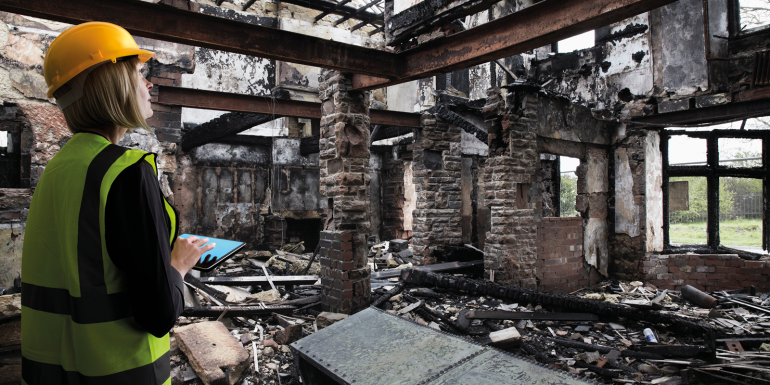Constructing after a fire

Mathew Fairie, Associate at Perega, looks at structural engineers’ roles and responsibilities in the remediation and reconstruction processes after a fire.
The restoration process following a fire is complex, requiring plenty of strategic decision-making to ensure structures are rebuilt resiliently, cost-effectively, safely and to building standards. Structural engineers are indispensable in this endeavour, acting as experienced overseers and advisors from initial assessments to final reconstruction or remediation.
The engineer’s role begins with conducting safety assessments to identify immediate hazards and making the site secure for further inspection and work. Managing asbestos is a crucial initial step, particularly in older buildings. This involves conducting surveys to detect its presence and implementing necessary measures for safe removal or containment.
Once safety is assured, the next stage involves a structural analysis to determine the extent and type of damage. This includes visual inspections and using measuring tools, including lasers, to detect deformations and assess material integrity. For timber, this means evaluating the degree of charring to decide whether it can be salvaged or needs replacement. For masonry and concrete, visible chemical changes such as colour alterations indicate fire damage, while steel assessments focus on detecting heat-induced deformations.
After assessing the damage, a critical decision is made to restore or demolish the building. If more than half of the structure is damaged, it is often declared beyond economic repair. However, historic or listed buildings may still require restoration despite significant damage due to their protected status. Engineers evaluate the integrity of steel frames, masonry and timber to determine restoration feasibility, with salvageable elements bookmarked to be redesigned and incorporated into the new structure.
Both the restoration and reconstruction process involve meticulous planning, including removing unsalvageable materials, drying out the property and rebuilding affected areas. Compliance with the latest building regulations and standards – including fire safety, structural integrity and insulation – is imperative.
Good project management
Engineers liaise with clients, prepare tender packages for contractors (including detailed specifications and drawings), evaluate contractor bids and select those with a proven track record in fire remediation.
Periodic site visits mean they can monitor progress, address issues and ensure operations stay aligned with the project plan. Clear and consistent communication throughout with all stakeholders – including clients, loss adjusters, contractors and regulatory bodies – is essential. Regular updates and transparent reporting help to manage expectations and maintain accountability, as well as providing a clear record for insurance and regulatory purposes.
Throughout the process, the focus is on standards. This includes upgrading insulation to create a lower-carbon building and installing fire-protection measures, such as fire breaks or using non-combustible materials, to increase resilience to future fires.
Detailed inspections at each construction stage are important to ensure work meets the standards of structural integrity, compliance with regulations and quality of workmanship. A comprehensive snagging and defect identification exercise will also resolve any minor defects before the final handover.
Collaborating with a qualified engineer after a fire ensures buildings are restored safely, efficiently and to expected standards. With the right care and resources, the expertise of structural engineers can transform disaster into an opportunity.
Image credit | Getty






